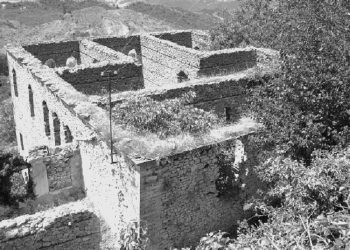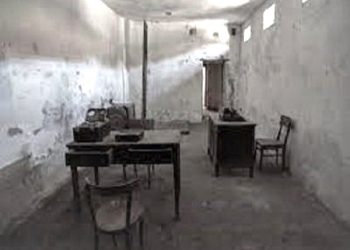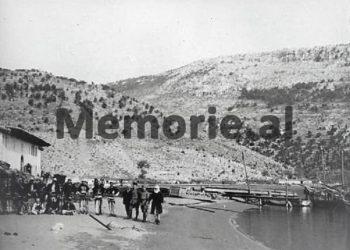Dashnor Kaloçi
The third part
Memorie.al publishes some archival documents with the logo ‘Top secret’ issued by the Central State Archive in Tirana (fund of the former Central Committee of the ALP) where are the minutes of the meetings of the senior party and state delegation of the Republic People’s Party of Albania, headed by the Minister of National Defense, Beqir Balluku, with the high delegation of the People’s Republic of China, headed by the chairman of the military commission at the Politburo of the Central Committee of the Communist Party of China, Ye Chen Ji, where discussed military issues, as well as the delegation led by the Minister of Trade, Kiço Ngjela, with the Chinese delegation led by the Chairman of the Council of Ministers of the People’s Republic of China, Chu En Lai, where economic problems were discussed, as Albania there was an urgent need for cereals, but the Chinese government could not help them, as as a result of the drought, they could not carry out their plans and were buying nin wheat that the French had imported from the Americans! Unknown documents published for the first time with the full minutes of the two meetings held in Beijing on November 7, 1972, where the Albanian military delegation headed by the Minister of National Defense, Beqir Balluku (where they took all directors of directorates and chiefs of different types of weapons of the Albanian army), it was requested that the Chinese government assist the Albanian army, with weapons of all types, starting from: light infantry weapons (rifles), artillery anti-aircraft, land and coastal, tanks, armored vehicles, ships, torpedoes for naval combat fleet, chemical weapons, equipment and engineering materials, liaison, radio location, vehicles, aircraft and helicopters, mechanical tank repair plants and armored personnel carriers, ammunition and explosives, background material, etc., because according to Minister Balluku, the Albanian army was in a very difficult situation in terms of armaments, because it had World War II armaments, which had been brought by the Soviets since the ’50s.
Continued from the previous issue
Fund: CENTRAL COMMITTEE OF THE ALBANIAN LABOR PARTY
Relations with the Communist Party of China
Contents: THE FIRST MEETING OF THE RPSH MILITARY DELEGATION (CHAIRMAN BY BEQIR BALLUKU) WITH CHINESE FRIENDS OUR PEOPLE, AND OUR ARMIES. ON THE GEOGRAPHICAL POSITION OF ALBANIA WHERE THE INTERESTS OF THE NATO AGREEMENTS AND THE WARSAW TREATY CROSS, THE CHAVINIST AND ANNEXIST GOALS OF THE STATES AROUND US. ON THE MEASURES TAKEN BY THE ALP, FOR THE DEFENSE OF THE COUNTRY AND THE SUBMISSION OF SOME REQUIREMENTS FOR STRENGTHENING THE DEFENSE.
THE FIRST PLENARY MEETING OF OUR DELEGATION WITH CHINESE FRIENDS, DATED 7.11.1972
ON ARMY ARMING
In equipping our army with weapons, we still have shortcomings without counting here their perspective and quality. In use, we still have old Soviet and other armaments, which is consumed to the maximum, with numerous defects, no spare parts, with little ammunition, and in constant expiration. In order to improve the quality of the armament, and to fill to some extent the existing organic deficiencies, we feel it necessary to present some requirements which as a whole consist of:
- In infantry armament
A number of the People’s Self-Defense Voluntary Forces, which are currently organized into squads and battalions, are not yet armed, and in the army we still have a considerable amount of 1953 infantry rifles. The demand for 50,000 infantry weapons new, is for these weapons to be introduced into the army. While the model 1953 weapons, to pass for the arming of the volunteer detachments of the popular self-defense.
- In ground artillery armament
In artillery completion of existing organics, we have many shortcomings. About 30 percent of the brigades are with two groups of three they should have. While, yes 30 percent of the groups, are with 8 fires from 12-18 that they should have. We have approximately such shortages in the artillery of the corps, and in that of the RKP. As a result of the shortages we have in the artillery armament, we are obliged to keep still a quantity of Soviet armament (45 mm. 76 mm. Regime, 130 mm. Jet production of the first years of the Second World War).
They have many defects and are impossible to repair, and not in permanent and full combat readiness. While another amount of armament, such as 82 mm.107 mm pazb cannons, and 107 mm mortars. are without spare parts and with a very small amount of ammunition. In addition to organic shortages and the replacement of Soviet armaments, there is a great need to improve the quality of artillery, especially in terms of increasing the amount of long-range weapons (122 mm cannons, 100 mm. 152 mm cannons). 152 mm. Of reactive artillery) and the introduction of self-propelled artillery (SALW), as the most maneuverable with higher throughput, more economical in human resources, and which also solves the problem of traction vehicles.
For our conditions where supremacy in the air, the enemy will have movement during the day will be difficult. Therefore mechanically towed artillery, mainly corps artillery and RKP artillery, needs to be with large range-throws that can support infantry and tank combat operations during the day, without changing firing positions by performing this action. only at night. With the current situation, the corps artillery has almost the same systems and calibers, as well as the brigade artillery, approximately the same situation is in the RKP artillery units.
Reactive artillery, as a very powerful weapon that creates in a very short time a large volume of fire and with great convenience, we have only 48 130 mm machines. organized in an RKP brigade. and 24 cars of the first Soviet type (1941). They are, in fact, not on standby as they are very old and with little ammunition expiring. Increasing the quantity of this artillery in our army, and improving its quality with reactive artillery with greater range, will increase the firepower of the army.
We also have a significant weakness in antitank protection. Our country, although considered a mountainous country in all coastal parts and in some directions of the land, allows the mass use of armored vehicles. Experience to date shows that the imperialist and revisionist states, in aggression against free and sovereign countries, have put in place the strategy of lightning invasion, using on a large scale for this purpose armored vehicles landed by air, sea, and land.
To withstand such aggression, we must have a stable and active MKT, with strong anti-tank reserves scaled to all depths, and composed of anti-tank tools and weapons of the time capable of fighting by any means enemy armor. In our request, in order to strengthen the MKT, especially in the brigade, corps, general command, we have started in these instances to create minimum anti-tank reserves consisting of caliber and various artillery systems, including guided missiles and self-propelled artillery, as the most effective weapons to fight with today’s tanks.
- On strengthening coastal artillery
As our country is known, there is a coastal border of about 410 km. which constitutes about 1/3 of the entire border of the Republic of Albania and can be landed anywhere by sea. The protection of the coastal direction occupies in our plans a very important place as the main operational-strategic direction. Since this direction is the fastest to lead to the most important political, economic, and military centers of our country, it is passable by all techniques.
For the protection of the coast in the absence of relevant artillery, we have placed ground artillery (76 mm. 85 mm. 100 mm. 122 mm. With cannon). These, due to their construction, are not fully capable of successfully fighting with today’s naval means. Coastal artillery, we have only 8 batteries of the Soviet model, and of these with radio location we have only 2 batteries. Even these batteries, standing for a long time of permanent standby (nearly 20 years), have begun to have defects and deficiencies for repair of which we have difficulty due to the effect of part of the replacement.
A serious weakness in the coastal artillery is the lack of automatic firing equipment and radio-locating stations. This, in turn, renders them inherently incapable of making effective fire at night and in conditions of limited visibility. Therefore, in the whole complex of coastal protection, we, comrades, add the need to strengthen and modernize the coastal artillery. For this purpose in our request are provided 24 batteries of coastal construction, equipped with all necessary instruments and apparatus (radio locator) of various calibers.
We also have surface-to-surface missiles (three groups) as very powerful weapons to hit the naval landing, at a long distance. A pronounced weakness in all artillery, we lack the means of detection. Today in artillery as detection tools, we have only the eye, binoculars, as well as some stereotypes. These stereotypes cannot provide long-distance fire detection and correction. The lack of other means of artillery detection makes it ineffective to fire artillery at night, and in conditions of limited visibility, which for our conditions are the main form of combat.
- Demand in ammunition
Given the distance between our two countries and to timely dispose of the necessary ammunition reserves for a long popular war, we raise the need to supplement our army with ammunition. Based on these conditions, our demand is 10 k / 1 for ground, coastal artillery, tanks, infantry weapons, and 15 k / 1 for anti-aircraft artillery.
ANTI-AIRCRAFT ARTILLERY
The development and growth of anti-aircraft artillery in recent years, in terms of armaments and equipment provided by the PR of China, compared to the past has made improvements. But nevertheless the problem of air coverage is the weakest point of our defense. The imperialist-revisionist states that surround us have great potential in the air force and thus will have complete supremacy in the air.
The small territory of our country, and the existence of nearby enemy air bases makes it possible for their aviation to be located in a very short time over the objects of our territory, with all types of combat aviation. It is understood that in the event of an eventual attack by land, sea, and air, or by air alone, against our country we must withstand a great intensity of enemy aviation flights. It is also known that nowadays potential enemies attach great importance to the development and widespread use of aerial-landing troops.
In the conditions of our military organization, that the cadre army with limited effectiveness opens into a massive army, and when our terrain, especially the coastal and central area, is suitable for mass air landing, we forcefully bring before us the all-round efficiency of air defense terrestrial.
We start from the principle that, in our conditions when the ratio of combat and transport aviation forces is completely on the side of the enemy, we base air cover mainly on air defense forces, anti-aircraft artillery, anti-aircraft machine guns, surface-to-air missiles, exploiting for this purpose the firing possibilities of the army and the armed people.
The current state of anti-aircraft coverage, despite the improvement made, is still very low in strength and means, both for covering units of army units, possible air landing regions, and for covering important political and economic facilities and military. Tank and ground artillery brigades have no organic means of covering themselves independently. In the infantry brigade staff, there are a total of 12 cannons, of which 4 are of 25 mm caliber. Soviets that create in defense a density of less than two fire muzzles per km / front.
The infantry corps in the organic anti-aircraft regiment has only 20 37 mm cannons double-barreled with limited height and distance of action, without equipment of radar tools and fire direction for effective actions day and night. Some potential airborne regions have poor coverage or worse, do not have it at all.
The coverage of the most powerful political-administrative building in Tirana is done with few means and is relatively weak compared to the required degree of coverage. Some of the most important military and economic facilities are completely covered. Part of the anti-aircraft artillery technique we currently have, such as 85 mm cannons and 25 mm, is very outdated because it has very low qualities for the fight against today’s aviation as well as shortages in ammunition.
For these reasons, as mentioned above, the real state of air coverage of our country and our army is a serious concern for us. The amount of weapons and anti-aircraft artillery equipment presented in our plan-request is equal to the above factors. It is low compared to the existing tactical-operational norms that are recognized again.
In determining the calibers, installations, and complexes of anti-aircraft artillery required, we started from the concrete conditions and air coverage requirements of our country and our army. To ensure a higher disposal efficiency, we submit the requirement for 57 mm calibers. 100 mm. with fire-fighting equipment and radars, as well as small and medium-caliber surface-to-air missile groups, capable of carrying out efficient operations both day and night.
To ensure high maneuverability and mobility and large fire volume as well, we require 37 mm balls. and 57 mm. self-propelled barges, which, to cover tank units in the conditions of the fight against airborne, will be more suitable. While to compensate for the gaps in the actions between different calibers in the range of heights, as well as in the distance, coverage area and the largest volume of fire, we required machine guns 14.5 mm. quadrangular.
In order to ensure continuity in the air cover operations with surface-to-air missiles for our current conditions, we think that it is necessary to have for these, the relevant ammunition in the measure of 5 combat kits. While to ensure their technical readiness, as well as not to burden the shipping industry for their arrival in the PRC for periodic repairs, it is necessary to have a repair base for them with the necessary capacity. Memorie.al
The next issue follows











